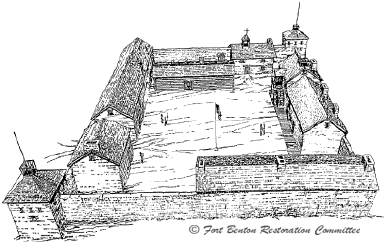 |
The remaining
monument to the old fur trading days of
Fort Benton stands on the banks of the
Missouri River. The old northeast
bastion is a mute reminder of the days
when all of Montana was an unexplored
wilderness, inhabited only by the tribes
of the northern plains. Into
this land penetrated the explorer,
mountain man, fur trader and the
voyageur, swinging his paddle in
time with his song. These men endured
amazing hardships, exhibited bravery,
courage and unrestrained conventions.
They dragged the
keel boats and the mackinaws up the
river, living on only dried meat and
occasional fresh game. They built
a dozen trading forts along the length
of the Upper Missouri during the years
of 1831 to 1846 using only the simplest
of tools. They took the work and
the hardship as it came, doing what they
knew how to do, living as they knew how
to live.
|
In the spring of 1846 the
American Fur Company's agent at Fort Lewis,
Alexander Culbertson, received a request from the
Blackfeet to relocate the fort to the north side of
the Missouri River. A broad grassy river bottom on
the north side a few miles down river was selected
and work began on the site of Fort Benton, the last
fur trading fort on the Upper Missouri. Fort Lewis'
log buildings, walls and bastions were dismantled
and floated to their new site. By the spring of 1847
the last structures were rafted down the Missouri to
became a part of the new trading post. But Alexander
Culbertson was not satisfied with his fort. While at
Fort Laramie he had seen the adobe buildings of the
Southwest, and he felt adobe would offer more
protection against the Upper Missouri's extreme
weather than logs could. Reconstruction of the fort
using adobe bricks made of Missouri River clay began
in the fall of 1848. A two story dwelling for Major
Culbertson was the first building completed.
Reconstruction was completed in 1860 when the trade
store was rebuilt.
Like all the other trading
posts of this region, Fort Benton was built in a
quadrangle. It was over 150 feet square exclusive of
the 20 foot square two story
Bastions or Blockhouses.
Portholes in the bastion walls for both cannon and
riflemen commanded a shooting range on all four
sides of the fort. An adobe wall fourteen feet high
connected all the buildings and enclosed the
quadrangle. Buildings contained within the compound
were the
Agents' Quarters or Bourgeois House, the
Engagee's Quarters, the
Trade Store and attached Warehouse,
the
Blacksmith and Carpenter's Shop, the
Kitchen, and the
Barn. A large timbered gate was
located between the northeast bastion and the long
warehouse. A smaller gate admitted Indians, a few at
a time, into an enclosure, a part of the trade
store, where they could pass their pelts and receive
goods in return ... at first some colored cloth or a string of beads
for a beaver skin and later for a buffalo hide. By
1900 only the crumbling northeast bastion remained
of the most important fur post during the final
years of the fur and robe trade. In 1908 the
Daughters of the American Revolution with donated
funds and $1500 received from the Montana
Legislature took it upon themselves to rescue this
last remaining structure. One of the oldest
buildings in Montana is still standing today because
of their efforts.
|